|
Unraveling Antique American
Samplers
by Bob Brooke
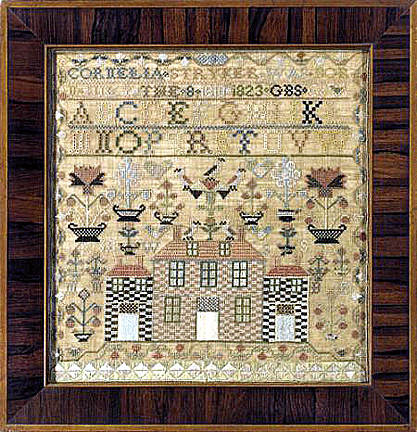 American
samplers fetch high prices, especially at Americana shows. There’s a
good chance that the unsuspecting buyer discovering a single one in
an antique shop will be taken, through no fault of the dealer. Most
antique dealers can’t tell real samplers from fake ones. It’s only
those who specialize in such things that can truly tell the
difference. American
samplers fetch high prices, especially at Americana shows. There’s a
good chance that the unsuspecting buyer discovering a single one in
an antique shop will be taken, through no fault of the dealer. Most
antique dealers can’t tell real samplers from fake ones. It’s only
those who specialize in such things that can truly tell the
difference.
According to the Smithsonian's National Museum of American History,
Loara Standish made the earliest known American sampler in Plymouth
Colony around 1645. Over the next two centuries, women created
samplers as a way to save different types of stitches or designs
they might want to use sometime in the future.
The earliest known American sampler was made by Loara Standish of
the Plymouth Colony about 1645. By the 1700s, samplers depicting
alphabets and numerals were worked by young women to learn the basic
needlework skills needed to operate the family household. By the
late 1700s and early 1800s, schools or academies for well-to-do
young women flourished, and more elaborate pieces with decorative
motifs such as verses, flowers, houses, religious, pastoral, and/or
mourning scenes were being stitched. The parents of these young
women proudly displayed their embroideries as showpieces of their
work, talent, and status.
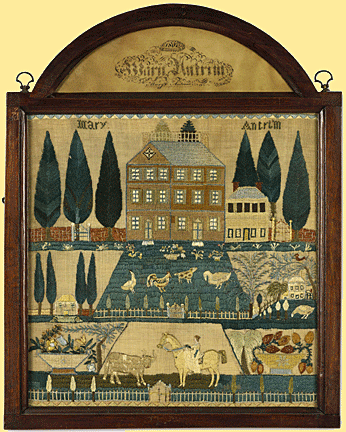 An
example of a 19th-century young girl's needlework could show the
extent and quality of her education as well as her religious and
moral convictions. Schoolgirls from wealthier families used more
expensive threads and learned more complicated designs or stitches
while those from poor families used samplers almost as resumes of
their abilities in an effort to gain employment in doing sewing. An
example of a 19th-century young girl's needlework could show the
extent and quality of her education as well as her religious and
moral convictions. Schoolgirls from wealthier families used more
expensive threads and learned more complicated designs or stitches
while those from poor families used samplers almost as resumes of
their abilities in an effort to gain employment in doing sewing.
Many early samplers do not have the letters “J” and “U” in their
alphabets because they were not part of the early Latin alphabet and
so the letter “I” was used for “J” and the “V” for “U.” The letter
“s” is often replaced with the printers “s” which looks like the
modern f.
While the samplers, themselves, don’t show much about the lives of
women in early America, the research people have done in diaries,
account books, letters, newspaper ads, local histories, and
published commentary has helped to illuminate their lives.
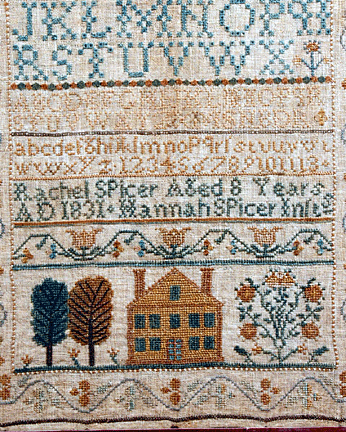 By
the 18th century, embroidered samplers as mere memory aids
disappeared and samplers became an integral part of the school
curriculum in genteel female education. They were educational tools,
much like a slate or horn board, that strived to develop a young
girl’s stitchery skills for both practical and ornamental purposes.
Samplers also developed secondary functions as girls were made to
sew upon them verses, poems, or tracts concerning life and death,
and the rewards of pious behavior. The execution of verses on
samplers, with increasingly more elaborate decorative motifs and
designs, provided practice for more intricate stitches and designs
along with the hope that reproducing such sentiments on cloth would
foster virtue, publicly exhibiting moral and needlework
accomplishments. By
the 18th century, embroidered samplers as mere memory aids
disappeared and samplers became an integral part of the school
curriculum in genteel female education. They were educational tools,
much like a slate or horn board, that strived to develop a young
girl’s stitchery skills for both practical and ornamental purposes.
Samplers also developed secondary functions as girls were made to
sew upon them verses, poems, or tracts concerning life and death,
and the rewards of pious behavior. The execution of verses on
samplers, with increasingly more elaborate decorative motifs and
designs, provided practice for more intricate stitches and designs
along with the hope that reproducing such sentiments on cloth would
foster virtue, publicly exhibiting moral and needlework
accomplishments.
Most girls’ sewing education began with simple marking samplers
consisting of several cross stitched alphabets, numerals, and
perhaps a few simple geometric motifs placed in ordered, horizontal
rows. After their completion, the makers of these marking samplers
could often go on to produce more intricate and individually
designed pieces. For other girls, the marking sampler was the extent
of their needlework education. Samplers that depict maps,
genealogical information, or detailed architectural elements were
also produced by young girls who benefited from a broadened
educational curriculum that later covered subjects like geography,
civics, and the natural sciences.
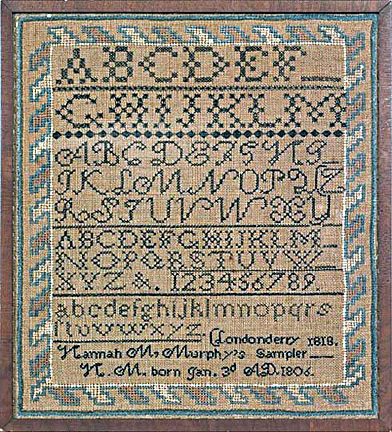 As
there was no standardization of curriculum, a girl could learn only
what her teacher was skilled enough to teach, but the multitude of
available teaching situations throughout the eighteenth century were
diverse enough and in demand by concerned parents and community
leaders, that most girls received some sort of education no matter
their social and economic circumstances. As
there was no standardization of curriculum, a girl could learn only
what her teacher was skilled enough to teach, but the multitude of
available teaching situations throughout the eighteenth century were
diverse enough and in demand by concerned parents and community
leaders, that most girls received some sort of education no matter
their social and economic circumstances.
Every sampler is a historical record of one girl’s educational
training and the type and value placed on that education. The
overall design, materials used, and design motifs give evidence of
her culture, religion, social class, and personal artistic
accomplishments and abilities. For well-educated girls of high
social class, samplers confirmed their genteel standing.
Samplers also benefited the poor or orphaned girl by teaching her a
trade in practical, marketable sewing skills for future self
employment. Sampler making was also seen as laying the groundwork
for religious piety, family responsibility, and civic virtue.
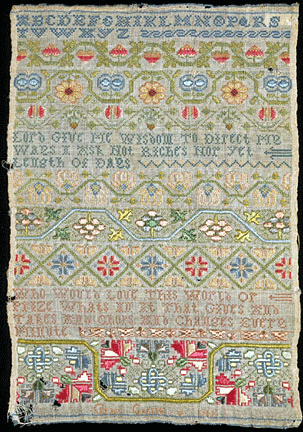 By
the 1850s, needlework, once a measure of gentility, became relegated
to an elective subject in female academies. The gradual spread of
public education and co-education among all classes of people pushed
sampler-making from the classroom to a pastime at home. The
increased use and availability of ink to mark textiles replaced the
laborious cross stitched letters on clothing and household textiles,
and the increased availability of paper, pencils, slates, and
blackboards were the preferred method for practicing letters and
numbers. By
the 1850s, needlework, once a measure of gentility, became relegated
to an elective subject in female academies. The gradual spread of
public education and co-education among all classes of people pushed
sampler-making from the classroom to a pastime at home. The
increased use and availability of ink to mark textiles replaced the
laborious cross stitched letters on clothing and household textiles,
and the increased availability of paper, pencils, slates, and
blackboards were the preferred method for practicing letters and
numbers.
Today, collectors consider samplers works of art, as well as
insights into the past. Subject matter ranges from a simple alphabet
to complex landscapes, Biblical scenes and passages, as well as
birth/death/ marriage records offering valuable genealogical
information. In the past, collectors overlooked samplers as ordinary
exercises in needlework, but today, they’re highly collectible and
can command extremely high prices. For example, a sampler, sewn by
New Jersey schoolgirl Mary Antrim sold at Sotheby’s for a over $1
million in 2012, while another fetched over $611,000 in 2003. Some
sampler makers used only thread and needlework to create them while
others used watercolors and paper and added embellishments like seed
pearls or beads.
There are plenty of samplers being made today specifically intended
to deceive unwary collectors in this lucrative tens-of-thousands to
hundreds-of-thousands-of-dollars market. The safest way to buy a
sampler, of course, is through a reputable dealer who has a
well-established reputation in sampler authentication. On the other
hand, the riskiest way to purchase one is through an online auction
site or an unknown online seller. Without being able to closely
examine the fabric used and other details, there's no way to know
for sure if a sampler is real or a fake.
 So
what are some ways to tell a fake or reproduction sampler from the
real thing? One of the first thing to check is fabric discoloration.
Old fabrics can darken in spots or brown to some degree in general,
but much of this depends on what type of fabric the woman used and
where it has been stored over time. So
what are some ways to tell a fake or reproduction sampler from the
real thing? One of the first thing to check is fabric discoloration.
Old fabrics can darken in spots or brown to some degree in general,
but much of this depends on what type of fabric the woman used and
where it has been stored over time.
There are no hard-and-fast rules when it comes to sampler age.
However, there are a couple of basic things to look for to make sure
the browning is authentic. Many times, fakers will add browning to
fabric by staining or darkening the fabric with tea or coffee. If a
sampler browns, it tends to do so naturally around the edges near
the frame, but blotchy browning should raise a cautionary flag.
Also, if the fabric is wrinkled as if it were twisted or bunched up
and the brown spots seem to follow that pattern, there's a good
chance the browning has been added deliberately.
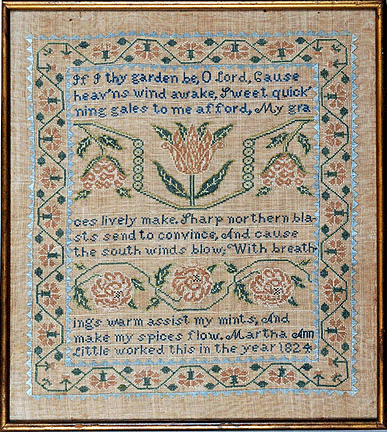 There
have been a few cases where the actual date sewn onto a sampler has
been altered to make the piece appear older—a "9" changed to an "8"
or a "6" changed to a "0." If there's no evidence of stitches having
been removed from the fabric and the piece is important enough, a
genealogical search can be done to determine the dates of the
needleworker's' life. If the sampler includes her age, would she
have been of the correct age during the year sewn into the sampler. There
have been a few cases where the actual date sewn onto a sampler has
been altered to make the piece appear older—a "9" changed to an "8"
or a "6" changed to a "0." If there's no evidence of stitches having
been removed from the fabric and the piece is important enough, a
genealogical search can be done to determine the dates of the
needleworker's' life. If the sampler includes her age, would she
have been of the correct age during the year sewn into the sampler.
Collectors interested in samplers from a particular region or school
will find it easier to use style and thread type to authenticate
them. By studying designs and types of thread used in a particular
region or school throughout the years, when they came into use and
when they stopped being used, it’s easy to date just about any
sampler. Certain designs or stitching styles may also be more
prevalent in a particular region, a certain school, or during a
specific time period. On the other hand, some designs or stitch
styles may not have been used at all by a particular school.
As with any antiques or collectibles in today’s market, it’s buyer
beware. Being educated about samplers is the best defense to being
taken.
<
Back to More Antique Spotlights
Next Article > |
